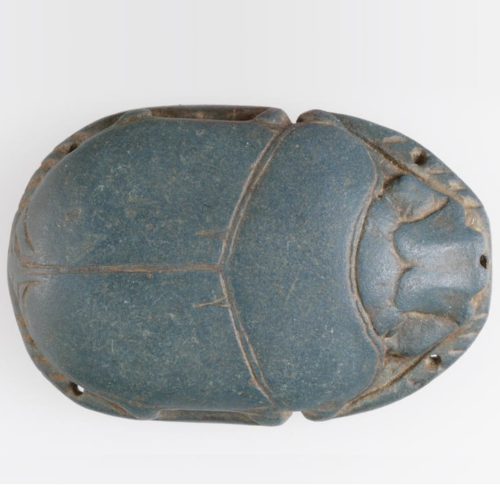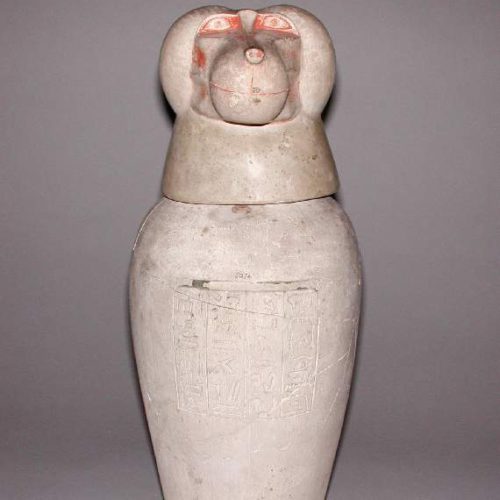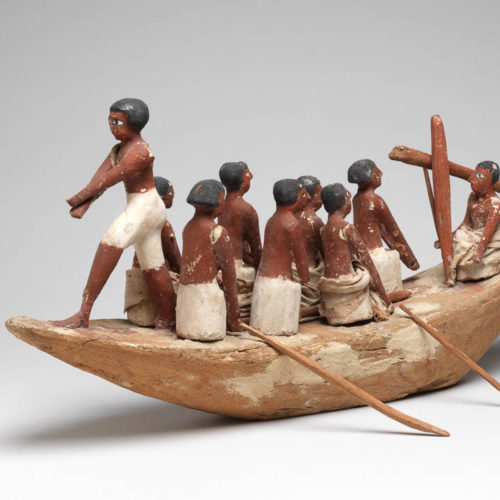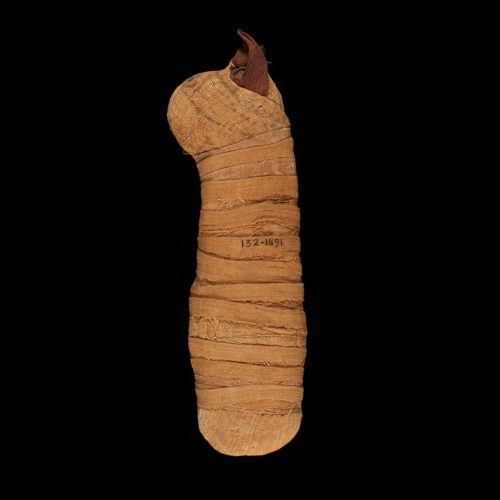The Ancient Egyptians believed that when people died, they could live on in the afterlife. The objects that were placed into tombs were things that would be useful in the afterlife, which had lots in common with life on Earth. Using these objects, we can learn about Ancient Egyptian beliefs, and what was important to them.
- What do you think are the most important things to place in a tomb for someone to use in the afterlife?
- How have these objects survived from ancient times until now?
- Sometimes Ancient Egyptians placed small models of objects rather than the full size versions into tombs. Why do you think this was?
- What do you think the Ancient Egyptians would think about these tomb objects being in a museum now?
- What sort of person might have taken these things to the afterlife?
- What might these objects have been used for in the afterlife?
- Try making a scarab beetle amulet from clay. You could copy some hieroglyphs to engrave underneath it.
- Tomb robberies have been a problem throughout history, and the Ancient Egyptians tried lots of different methods of keeping robbers away. Lots of these objects were taken out of tombs. Do you think this is fair? Discuss your ideas with others.
- The Ancient Egyptians believed that there would be a river in the afterlife, just like the River Nile in Egypt. Why are rivers so important to people? Make a list, and then transform it into a shape poem that shows the route of the Nile.
- Ancient Egyptian society was complex with a wide variety of different roles and responsibilities for people. Think about the following jobs: coffin painter, carpenter, priest, mummy embalmer. Think of the questions you would ask to find out if someone would be good at these jobs. You could act them out in an interview.
Talking about death, human remains, and the beliefs and rituals concerning end of life can be difficult. Be sensitive to those in your classroom community who have recently experienced any kind of bereavement, or who may feel anxious discussing these topics.
Be prepared by offering alternative activities for those who find this too uncomfortable, but try to make space for those who want to explore and discuss their thoughts and feelings about death as well. Get support for yourself from colleagues or professional organisations if you need it.
These objects were important to the people who owned them. Some of these items were removed from tombs by European travellers without the considerations that we might take today. Most of the artefacts in our ancient Egyptian collections were brought to England from university-funded excavations, with the consent of the Egyptian government at the time. Now, our archaeological practice is collaborative.
Much material from ancient Egypt is no longer in ancient Egypt. You could discuss this with your class. Is it fair to disperse things far away? Be aware that this could be the case for some of your students’ heritage, too.
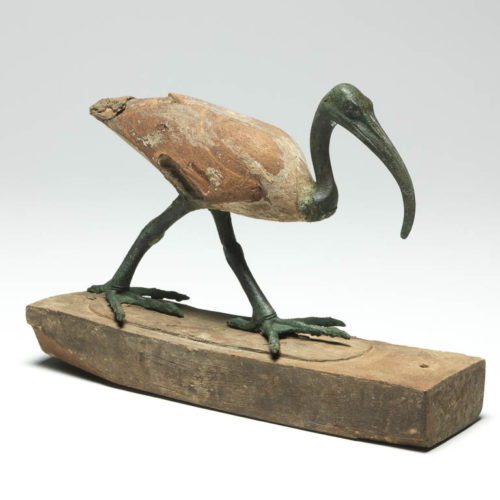
The Ibis
Look at this bird’s long thin legs. They would have been perfect for wading through the swamps at the edge of the Nile where the papyrus reeds grew.
In the Ancient Egyptian religion, the sacred ibis was associated with the god Thoth, who was the god of wisdom and writing. Large numbers of mummified ibis have been found near temples. Archaeologists have found several million of them! We think they were bred at the temple and then mummified so that worshipers could buy them and give them as offerings in honour of Thoth.
The Scarab Beetle
Scarabs, or dung beetles were, and still are, found throughout Egypt. They eat all the undigested nutrients that are found in the poo of other animals such as cows or goats!
Adult beetles lay their eggs underground, and then the babies hatch out as if by magic. For the ancient Egyptians, the idea of coming to life from nothing was extremely powerful. Scarab amulets were made into jewellery and placed into tombs, even included inside mummy wrappings, so that people could be protected by this powerful symbol of life.
Based on their observations of scarabs pushing balls of dung much bigger than their own bodies, the Egyptians also imagined the god of the morning sun, Khepri, as a scarab beetle, pushing the sun up into the sky.
Why did the Ancient Egyptians mummify dead bodies?
The ancient Egyptians believed that after a person had died, their body needed to be carefully preserved so that it could provide a home to the souls in the afterlife.
There were many different ways to carry out the mummification process, which changed over time. Wealthy, high status people generally had more elaborate mummification than poorer people.
How did they mummify a body?
1.Washing
Before mummification began, the body needed to be purified by washing. This was important not just for hygiene, but because water was associated with purification and life, and was linked to rebirth.
- The Removal of Organs
Next, the internal organs – lungs, liver, intestines and stomach – were removed by an operation. These organs were mummified separately and placed in canopic jars [click for more]. The heart was left inside the body as the ancient Egyptians believed it controlled thinking and memory, and would be needed in the afterlife. The brain was not needed so was removed through the nostrils and thrown away.
What were canopic jars for?
Canopic jars contained preserved organs. They were buried in the tomb with the mummy. There were four in a full set: one each for the lungs, liver, stomach and intestines. The organs were preserved and wrapped, put into the jars and then placed in the tomb next to the coffin. When it was time to be reborn in the afterlife, the preserved organs would re-enter the body and start working again.
The lids of the jars show the four sons of Horus, who each protect one of the organs.
Imseti human-headed
Hapy ape-headed
Duamutef jackal-headed
Qebehsenuef falcon-headed
- Drying
Natron, a kind of salt, was used to dry the body. It was placed on the outside of the body and also in linen bags inside the body cavity, until it had dried out completely. This process took several weeks.
- Packing
The whole body was then washed with Nile water. The body and head were packed with a linen, (or sometimes sawdust or earth) to make a more natural shape. The operation cut was sewn up, the nose was blocked, and pads of linen were placed under the eyelids.
- Anointing and Adornment
Oils, spices, perfumes and resins from trees were rubbed and sprinkled onto the skin to make it smell nice and to care for the skin. The Egyptians thought that this would make the body smell ready for the world of the gods in the afterlife. The body was treated with great care, and make up and hair products were used to make the person look their best.
Did you know?
As part of this process, the bodies were covered in hot sticky resin. Later on, people examining mummies thought that this resin was tar or bitumen (called mummiya in Arabic). The English word, ‘mummy’ comes from the Arabic word ‘mummiya’.
- Wrapping
The body was then wrapped carefully in many layers of linen. Head and limbs were wrapped first and then the whole body. Protective amulets and pieces of jewellery were placed within the wrappings and appropriate protective prayers and spells were recited during the ritual.
One of the prayers ends “you will live again, you will live forever”.
In later times, some of the bandages were dyed red-pink with plant dyes. This was a solar colour and is thought to represent the life giving powers of the sun.
- Masks and Decoration
In the later periods, mummy masks began to be used. The mask protected the head and also gave a perfect version of the dead person’s face that could be used in the afterlife.
A pharaoh might have a gold mask, but ordinary people would usually have masks made from cartonnage, linen or plaster. In the Roman period near the end of Ancient Egyptian times, portraits painted on wood were used.
Picture of Mummy Mask of Thay (2106-1963 BC) E198.1903
- Coffins
The complete mummy was then placed in a coffin and taken for burial
What does a mummy look like?
This mummy is nearly 2000 years old. (E63-1903) That’s actually not very old for an Ancient Egyptian mummy!
From x- rays it’s possible to tell that the man inside the wrappings was around 30-35 years old when he died. They also show that his organs have not been removed, but have been preserved inside the body. That was quite normal for mummification at this time.
The portrait of his face looks more European in style than we might expect because although it was made in Egypt, Roman styles were having a big influence at this time. The golden wreath on his hair and the beard style are traditional Roman features.
His mummy wrappings are dyed red and painted with Egyptian symbols. Can you see a winged sun disk, falcons and Anubis the mummification god on his body? And an eye symbol on each shoulder? These are all magical protections for the dead person.
How did the Ancient Egyptians get their food?
The Gift of the Nile
When you imagine Ancient Egypt, you probably think about the treasures and monuments of the pharaohs and the wealth and splendour of the pyramids and tombs. However, a lot of Ancient Egypt’s success was thanks to the farmers and labourers who supported the whole society.
The River Nile which runs through the centre of Egypt, flooded on a predictable yearly basis, leaving behind fertile soil in which crops could be grown. Being able to rely on the crops meant that people in Ancient Egypt were able to establish settlements that grew into complex cities.
What did they grow?
The most important crops grown were wheat and barley, which were used to make bread and beer, the staple diet of most Egyptians. In addition, people might have grown a small amount of fruit and vegetables at home, and perhaps also kept animals such as goats or sheep.
Larger farms might have grown flax which could be spun and woven into linen, or reared cattle for meat. Only the rich could afford to eat beef.
Most Ancient Egyptian people ate fish or duck for protein.
How did they store their crops?
Bread was the staple of the Egyptian diet. Grain needed to be stored so that it could be used to make bread throughout the year. It was important to be organised about this to make sure that there was enough to share around, and to design and build the granaries carefully so that the grain was protected.
At harvest time, grain was collected to be stored in these buildings. Scribes and officials went into the fields at harvest time to observe and record the harvest as it was being collected and check that none had been lost or stolen. That’s what you can see happening here.
How did the Egyptians make bread?
This model shows eight people working on the processes needed to turn the grain into bread and beer.
The women at the back are using stones to grind the grain into flour. The flour would have contained sand and stone dust, and so it was important to sieve it to get rid of those things. That’s what the woman at the front is doing.
Next, the flour is mixed into dough and then shaped into loaves to be baked in an oven.
At the back of the model we can see a man carrying water jars, while another sieves lumps of bread into a huge barrel of water. The bread is only partly-baked which means that it contains enzymes that will fizz and bubble in the water, turning it into beer.
What were these tomb models for?
Ancient Egyptians believed that models, like the ones pictured above, could become magically active in the afterlife. They placed them in tombs so that the dead person would be provided with everything they needed in the afterlife. These models are interesting for us as historians because they give us lots of information about daily life in ancient times.
